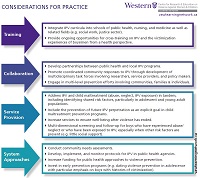Considerations for Practice in Preventing Violence Across the Life Course
 This infographic provdes training, collaboration, services provision and system approaches information that can be implemented into practice to address IPV and the victimization of boys/men.
This infographic provdes training, collaboration, services provision and system approaches information that can be implemented into practice to address IPV and the victimization of boys/men.
View Inforgraphic(PDF)
View Infographic(Image)
View Plain Text PDF
Training:
- Integrate IPV curricula into schools of public health, nursing, and medicine as well as related fields (e.g. social work, justice sector).
- Provide ongoing opportunities for cross-training on IPV and the victimization experiences of boys/men from a health perspective.
Collaboration:
- Develop partnerships between public health and local IPV programs.
- Promote coordinated community responses to IPV through development of multidisciplinary task forces involving researchers, service providers, and policy makers.
- Engage in multi-level prevention efforts involving communities, families & individuals.
Service Provisions:
- Address IPV and child maltreatment (abuse, neglect, IPV exposure) in tandem, including identifying shared risk factors, particularly in adolescent and young adult populations.
- Include the prevention of future IPV perpetration as an explicit goal in child maltreatment prevention programs.
- Increase services to ensure well-being after violence has ended.
- Multi-dimensional screening and follow-up for boys who have experienced abuse/neglect or who have been exposed to IPV, especially when other risk factors are present (e.g. little social support).
System Approaches:
- Conduct community needs assessments.
- Develop, implement, and monitor protocols for IPV in public health agencies.
- Increase funding for public health approaches to violence prevention.
- Invest in early prevention programs (e.g. dating violence prevention in adolescence with particular emphasis on boys with histories of victimization).
This infographic emerged from the Issue-Based Newsletter 20: Links between the maltreatment of girls & later victimization or use of violence.
This collection of Learning Network resources is designed to synthesize and disseminate knowledge on topics related to Gender-Based Violence (GBV). These resources provide foundational GBV knowledge including commonly used language, important gaps and emerging issues, recent research, and important educational tools and resources.
All original materials produced by the Learning Network are open-access and can be re-used and re-distributed as long as there is proper recognition of the author and/or Learning Network.
All our resources are open-access and can be shared (e.g., linked, downloaded and sent) or cited with credit. If you would like to adapt and/or edit, translate, or embed/upload our content on your website/training materials (e.g., Webinar video), please email us at gbvln@uwo.ca so that we can work together to do so.






